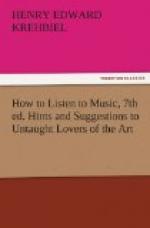[Sidenote: The Symphony.]
[Sidenote: Mistaken ideas about the form.]
As the highest type of instrumental music, we take the Symphony. Very rarely indeed is a concert given by an organization like the New York and London Philharmonic Societies, or the Boston and Chicago Orchestras, at which the place of honor in the scheme of pieces is not given to a symphony. Such a concert is for that reason also spoken of popularly as a “Symphony concert,” and no confusion would necessarily result from the use of the term even if it so chanced that there was no symphony on the programme. What idea the word symphony conveys to the musically illiterate it would be difficult to tell. I have known a professional writer on musical subjects to express the opinion that a symphony was nothing else than four unrelated compositions for orchestra arranged in a certain sequence for the sake of an agreeable contrast of moods and tempos. It is scarcely necessary to say that the writer in question had a very poor opinion of the Symphony as an Art-form, and believed that it had outlived its usefulness and should be relegated to the limbo of Archaic Things. If he, however, trained in musical history and familiar with musical literature, could see only four unrelated pieces of music in a symphony by Beethoven, we need not marvel that hazy notions touching the nature of the form are prevalent among the untaught public, and that people can be met in concert-rooms to whom such words as “Symphony in C minor,” and the printed designations of the different portions of the work—the “movements,” as musicians call them—are utterly bewildering.




